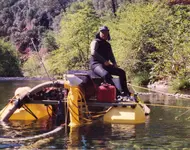Got 15 years of drift boat and raft experience, and FWIW I would never even consider
taking a raft or DB down a river I that I had -0- knowledge of, and getting IN the
water to try and steer a loaded raft is a bad idea from the get-go.
If you can walk that raft down, that's one thing, but if your swimming along with
it in the current then I hope you're "prayed up", as you could be meeting the Big Guy
a lot sooner than you think..lol. Trying to "steer" a heavy raft in a strong river current is
pretty much impossible, even if you're in it and you have oars.
If there are deep water areas (over your head) where you need to swim, you have
to be SURE that you won't pass over any large boulders that are a few feet under.
In that current, the odds are high there's a pretty good suckhole right on the downriver
side of that boulder, and it can grab you and suck you right to the bottom in a NY second.
Once you bounce off the boulders on the bottom a couple times, it might spit you
back out, but then quite often the current is so strong you're trapped.
I've screwed up and got sucked into a few of those suckholes in both 16' and
18' fiberglass drift boats, and on both occasions the current caught a chine and
started sucking the boat down, and if my clients and I hadn't quickly
transferred our weight to the "upside" it could have been disastrous.
Best suggestion is that you find high points along the rivers path, and get
up there and look down on the river. Pick a day when the water is clear, and
you'll be able to see *most* of the potential problem areas. Better yet, walk
the bank down the stretch you plan to raft and take special note to any
mid-river current changes, as they are often the tale-tale signs of deep, large
boulders. Are there any bars to cross? If so, if your raft is "hanging low" you
very well might have to portage around them (bunch of flippin' work!).
I live on a protected, wilderness area river that typically flows about
16,000 cubic FPS, and although I've drifted it a couple hundred times in
my own boats, it's been a couple years since my last trip. Before I ever
dropped the boat in the water I would call a guide friend up and ask about
any changes, new snags, sweepers or anything else I need to be aware
of.
Rivers change constantly, so make sure any info you get is current to
the last high-water event. Boulders can get rolled by heavy flood currents,
and deadly stumps can pop-up on any snag at any time. I've rowed a number of
Class III rivers, but there are some rivers here in WA. that are loaded with
trophy steelhead (or
used to be) where I wouldn't even consider trying
with my own boat but called (and paid) a local guide who rowed it every day
and knew that water like the back of his hand. That guide could really handle
a boat, but I still got the sheite scared outta me a few times as we dropped
through a few boulder-strewn chutes.
Last but most important of all: Please,
PLEASE do not get in that water
in a raft or anything else without a proper
floatation vest.
I've helped pull more than one body from the river here, and not a one had a
flotation vest on. The crap can hit the fan in an instant, and then you're suddenly
in that very cold, fast moving water. If it's cold snowmelt, you've got about 5 min.
before hypothermia sets in (vest or not) and that's when that irritating vest
saves your life.
Honestly though, I think drifting it down is an awesome idea!

Getting the raft and gear to the destination in one piece is another thing, and
if that river is fished by any guides, it may be well worth it to hire one for a
day and have them ferry your gear down for you. You might spend $300 for
the guide, but if it makes all the difference in getting your gear (and YOU) there
safely, it'll be $300 well spent on keeping you alive and your gear off the rivers bottom.
Me? I'd do the homework, then go for it...










 , scared and absolutely could not move. I REALLY wanted to get out but it felt like I was in cement! I told my buddy I had to let go, rolled over and fortunately was able to get out on the other side, just before the current slammed into a canyon wall. The ONLY reason I had that extra time to survive and tell this story was because of what I was wearing; Booted chest waders, life jacket and a raincoat tied off at the waist. My buddy got water in his waders as he tried to cross and sank like a rock. I saved him tho.
, scared and absolutely could not move. I REALLY wanted to get out but it felt like I was in cement! I told my buddy I had to let go, rolled over and fortunately was able to get out on the other side, just before the current slammed into a canyon wall. The ONLY reason I had that extra time to survive and tell this story was because of what I was wearing; Booted chest waders, life jacket and a raincoat tied off at the waist. My buddy got water in his waders as he tried to cross and sank like a rock. I saved him tho. 